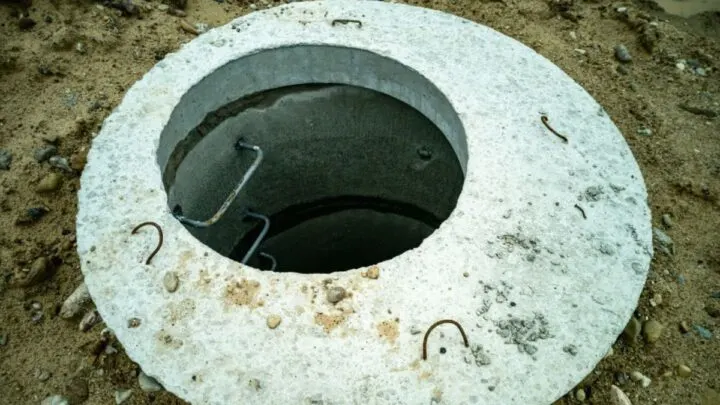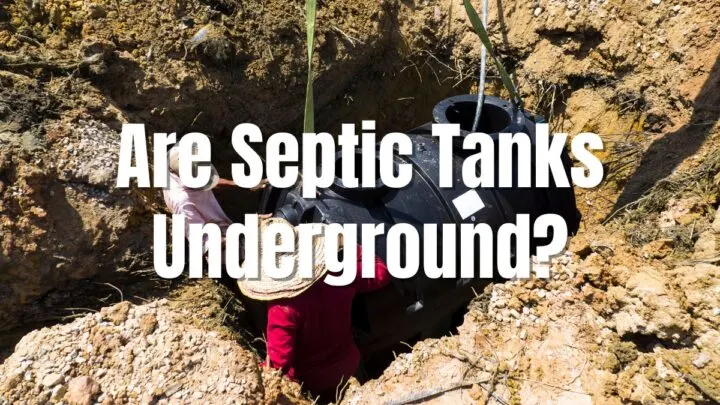Septic tanks are located underground and function as wastewater treatment systems.
They are an older form of wastewater treatment and are typically found in rural areas and places that do not have centralized sewer systems.
If you live in a house with a septic water treatment system, it’s good to know a bit about how the tanks work.
Here we give you a brief explanation of how septic tanks work, what their components are, and why they are built underground.
Are There Any Above-Ground Septic Systems?
While most septic tank systems are built underground, there are a few exceptions.
In areas where installing an underground septic tank may be challenging, there are some above-ground alternatives that people often prefer.
For example, if the surrounding soil is highly absorbent, and has a high water table or a restricted layer of bedrock, installing an underground septic system becomes very difficult.
In these cases, homeowners often install an above-ground septic system, such as a sand mound septic system.
While these aren’t very common, they can serve as a helpful alternative where installing the conventional underground system is not possible.
Why Are Septic Tanks Important?
A septic tank system uses natural processes and technology to store and partially treat wastewater from your toilets, kitchens, laundry, and bathrooms.
Septic tanks allow the safe disposal of wastewater for homes in remote areas that aren’t connected to main sewage lines.
If you live in an urban area with a centralized sewer system, chances are you’ve never even heard of a septic tank.
But in regions where the infrastructure is not so modernized, septic tanks are an integral part of any house design.

Structure and Design Of A Septic Tank
A septic system comprises a septic tank and a drain field, also known as a soil absorption field.
The septic tank itself is an underground, watertight container made of concrete, fiberglass, or plastic, usually rectangular or round.
They are typically installed under the ground about 15 to 20 feet away from the house and are made up of two chambers. It cleans the wastewater by digesting organic matter and separating oil, grease, and solids.
The waste liquid, called effluent, flows from the tank into perforated pipes in the leach field, where it is slowly released into the soil.
Some septic tank systems are specially designed to disinfect the water or evaporate it before it is discharged into the ground.
How The Septic System Works
The septic tank is connected to two pipes, one inlet, and the other outlet.
The inlet pipe transports the wastewater from the plumbing in your house to the septic tank.
The wastewater stays in the tank long enough until the liquid and solid waste separate.
When the water is collected for long enough, it separates into three layers. These are:
- The topmost layer (called scum), which is comprised of oil and grease and floats over the other two layers.
- The middle layer is the wastewater itself, along with the dissolved waste particles.
- The bottom layer is called the sludge. This is the solid waste and particles that are heavier than water and sinks to the bottom of the tank.
The pre-processed wastewater from the tank leaves through the outlet pipe (also called the drain field) and is evenly spread over the surrounding soil.
Most of the solid waste is broken down by bacteria inside the septic tank into liquid and water, which drain away. The solid waste leftover in the bottom of the tank must be regularly removed as a part of maintenance.
Step-By-Step Process
Here is a detailed, step-by-step breakdown of how an average septic tank system works.
- Water from your bathroom, kitchen and laundry room travels through a drainage pipe and is emptied into your underground septic tank.
- The tank serves to hold the wastewater. The wastewater accumulates in collected in the tank for long enough till it separates into 3 layers of scum, wastewater, and sludge.
- The liquid wastewater exits the septic tank and is emptied onto the drain field.
- The wastewater is discharged over porous pipes, from where it is slowly and gradually absorbed into the soil. This process needs to be gradual so the drain field does not overflow with liquid and cause sewage to back up in your sinks and drains.
- The soil treats this wastewater, gradually restoring it to groundwater.
- The wastewater percolates into the surrounding soil, naturally removing contaminants, harmful bacteria, and viruses.
This process is not as efficient and technologically advanced as modern-day sewage treatment systems, and septic tanks also require regular maintenance and cleaning.
However, a septic tank system is still an adequate wastewater treatment system for homes in remote or rural areas which do not have access to centralized sewage systems.
For individuals living in such houses, an underground septic system is extremely vital as it lets them use water facilities as usual.
Summing Up If Septic Tanks Are Underground
In all but a few cases, most all septic tanks are located underground around 20 feet away from the house. These tanks help treat and reprocess the water that drains from the house and allows for bacteria and waste to get cleaned out.


